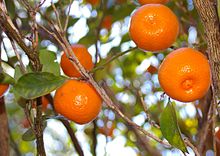Calamondin
| Calamondin ×Citrofortunella microcarpa |
|
|---|---|
 |
|
| Scientific classification | |
| Kingdom: | Plantae |
| (unranked): | Angiosperms |
| (unranked): | Eudicots |
| (unranked): | Rosids |
| Order: | Sapindales |
| Family: | Rutaceae |
| Genus: | ×Citrofortunella |
| Species: | × C. microcarpa |
| Binomial name | |
|
× Citrofortunella microcarpa (Bunge) Wijnands |
|
| Synonyms | |
|
Citrus microcarpa |
|
Citrus microcarpa
Calamondin (× Citrofortunella microcarpa or × Citrofortunella mitis) is an important citrofortunella, meaning that it is an intergenetic hybrid between a member of the genus Citrus (in this case probably the mandarin orange) and the kumquat, formerly considered as belonging to a separate genus Fortunella.
Calamondin is used mainly as an ornamental tree, rather than for food, although the fruit is edible.
Calamondin is called by many names, including: calamonding, calamondin orange, calamansi, calamandarin, golden lime, kalamunding, kalamansi, Philippine lime, "හින්නාරං", Panama orange, Chinese orange, musk orange and acid orange.
Even the botanical name has its portion of confusion, the calamondin was formerly identified as Citrus mitis Blanco, C. microcarpa Bunge or C. madurensis Lour., all those referred to it as a citrus. Lately it has been given the hybrid name| × Citrofortunella mitis by J. Ingram & H. E. Moore.
Calamondin is widely cultivated in the Philippines, where it is called kalamansî [kɐlɐmɐnˈsɪʔ] by the Tagalogs, kalamunding or calamansi by the Kapampangans, and limonsito or simuyaw [sɪˈmujɐw] by the Visayans. In Malaysia it is known as limau kasturi. Calamondin also grows in the northern parts of Indonesia and southern China. It is available year-round in the Philippines and is usually seen in its unripened green state. When left to ripen it turns a tangerine orange.
...
Wikipedia
